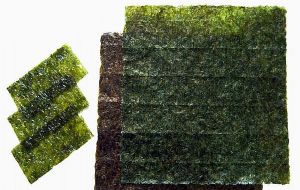MercoPress. South Atlantic News Agency
Chile breakthrough in (Asian nori) algae cultivation
 Nori sheets used to roll sushi is a 5 billion US dollars market.
Nori sheets used to roll sushi is a 5 billion US dollars market. Scientists of Chile’s Universidad Católica (UC) have discovered several varieties of the algae Porphyra in Chile. The Department of Ecology at UC has been studying the details of the reproductive cycle of the algae in order to replicate it in the lab
The seaweed provides the main ingredient that can be used to make nori sheets, which are used to roll sushi, with the same nutritional value, taste, and texture as those produced in Asia.
Nori sheets provide a market of 5 billion US dollars annually, with sales concentrated in Japan, Korea and China, according to Dr. Bernabé Santerlices, who directs the algae research. Not only does Chile have the algae and the sea necessary to create nori, Chile should be able to do it better than virtually any place else in the world, he said.
Of course, Chilean nori will require cultivation.
Although the algae is found in the waters of southern and central Chile, it doe snot naturally grow in large quantities. The reproductive cycle of the delicate algae includes the production of gametes and the germination and release of spores that eventually grow into algae blooms.
“We are working on how to patent the process” Santerlices said. To do this, they must find crucial details such as the optimum conditions of light, temperature and nutrients required for successful cultivation.
On an industrial scale, cultivation would take place in warehouses where the varieties of Porphyra grow in trays of shells covered by ocean water. After an eight-month germination process, the spores are ready to be submerged in the real ocean, where they grow into algae in nets suspended in the sea. The south of Chile provides the best conditions for algae cultivation, with the algae growing between September and November.
Other good news for Chile’s possible future nori market is that its uses go beyond gastronomy. Once the algae are dry, 35 – 42% of its weight is protein, which can be used in the production of dietary supplements. Furthermore, the red pigment in some strains of porphyra is valuable ingredients in sun-block products.
Beyond finding a way to patent the process, Santelices says virtually the only thing needed to put Chile in the nori business is a company to “take the project to the beach and get it going.”
By Maria Grusauska - Santiago Times




Top Comments
Disclaimer & comment rulesCommenting for this story is now closed.
If you have a Facebook account, become a fan and comment on our Facebook Page!